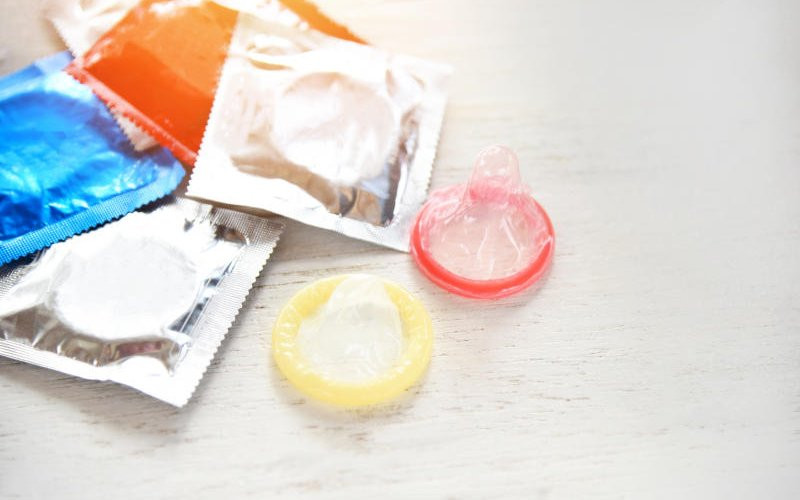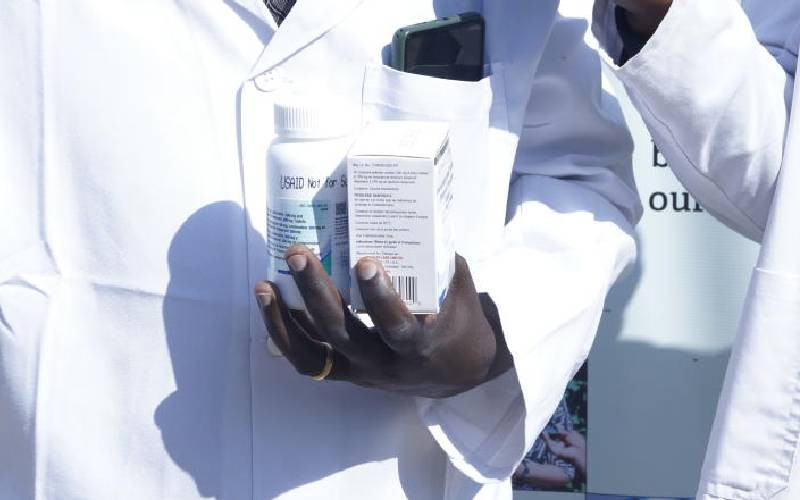By Kwamboka Oyaro
At international conferences many activities take place at the same time, giving delegates a variety of choice on what to attend or not.
Because of this, speakers end up presenting to nearly empty rooms at times.
 |
Path’s Nienke Blauw demonstrates how a female condom is used. [PHOTO: KWAMBOKA OYARO/STANDARD] |
So it was a pleasant surprise when the room where an official demonstrating proper use of female condoms was filled to capacity, with curious men and women stretching their hands to touch the smooth product as well as sniff the flavoured ones.
Using a model, Path’s Nienke Blauw, methodically demonstrated how the female condom is inserted. The venue was at the 2011 International Conference on Family Planning in Dakar, Senegal. She was bold.
And she needed to be if only to draw attention to this family planning and HIV prevention method that is yet to enjoy good reception since it hit the market in 1993.
It is a matter of concern that unlike male condoms, which are user-friendly and used in large numbers partly because of their affordability and availability, the female condom has not caught up.
Some users cite cost as a hindrance, since it costs up to four times more than the three-pack male condoms. Others say it is cumbersome to use.
Besides, it is not found in the kiosk next door like the male condom. And family planning proponents have not marketed it as much as they have done the male condoms.
While penile models were made long ago to help demonstrate how a male condom is used, many people in the room were seeing the female model for the first time.
Male partners
This is nearly ten years after the female condom was introduced to make women decide on their sexual health instead of relying on their male partner to use condoms.
Like a biology teacher, Nienke demonstrated how the condom is opened and used.
"The beauty of the female condom is that you insert it up to four hours before you have sex, so it takes up the body temperature and by the time the couple has sex, it is pleasurable and as close to natural as possible. The advantage is that you don’t interrupt the love-making process like you do when using male condoms," says Nienke.
Stay informed. Subscribe to our newsletter
As she passes the condoms — including strawberry and vanilla flavoured ones — around for her keen listeners to feel their smoothness, Nienke unleashes the new-look condoms, The Woman’s Condom, which will be available for sale early next year.
They are designed like tampons to allow easy insertion. The tip is a dissolving capsule which is not harmful to the body, explains Nienke. The pack comes with a water-based lubricant to be applied at point of use.
Path, a global health organisation, came up with the design in response to complaints about the existing ones being cumbersome to use. Some said the size discouraged them despite their desire to be in charge of their reproductive health.
This further poured cold water on women’s choice of the female condom as a family planning method as well as for prevention of STDs and HIV/Aids.
Says Nienke: "This is the only product that gives a woman an upper hand in choosing safety as well as pleasure without fear."
World population
Nienke’s fire was reflected in the general mood at the conference. Speaker after speaker spoke of the significance of encouraging people to take up contraception, especially long-term methods to plan their families.
Over the years, resources have dwindled and continue to be strained as the world population balloons.
Six months ago, respected science journal Lancet reported that hormonal contraception increased risk of contracting HIV. This sent panic waves among partakers of contraception and proponents of family planning are not sure whether it made women abandon injectables and other hormonal birth control methods.
According to the World Health Organisation, 150 million women use hormonal contraception worldwide.
Family planning experts at the conference disputed the Lancet report saying the evidence used to support the article were inconclusive studies whose methodology was questionable.
One thing, however, is certain: use of hormonal contraception does not prevent one from contracting HIV but it is for avoiding pregnancy.
That is why the male and female condoms are a must-use for everyone who is sexually active – to keep safe from contracting STDs and HIV/Aids.
Health experts defend contraceptives in link to HIV
This year, the world welcomed its seven billionth member on October 31.
But about three months earlier, a damaging report in respected journal Lancet claimed that hormonal contraception exposes users and their partners to HIV/Aids.
The latter news alarmed proponents of family planning especially in Sub-Saharan Africa where population-related issues such as high maternal and newborn mortality make contraception the best way to reduce this.
Panelist Emmanuel Otolorin, in discussing hormonal contraception at the recent International Conference on Family Planning, said validation was needed for the eminent journal’s "allegation of hormonal contraception increasing risk of HIV." Indeed, he said, the study had no verification as it was observatory.
"Women need dual protection...hormonal contraception to prevent pregnancy and condoms to prevent HIV," said Otolorin.
Dusenge Ariane, a nurse from Rwanda who works with youth on sexual health, said the report was unfortunate as many people believe the media.
"This takes us back, destroys achievements made in encouraging family planning, which is a way to fight the endemic maternal and newborn mortality," said Dusenge.
Preferred methods
Ward Cates, president of research at FHI 360, said women should continue using their preferred methods of contraception but if at risk of getting HIV, then they should use preventable methods as well.
"For 25 years, studies have been done to find out effects of contraception and 17 of them published but they have all been inconsistent," Cates said.
Speakers agreed to start the New Year with aggressive campaigns to reassure women to continue using the contraception because they are popular among women and gains have been made as a result of their effectiveness.
It was noted that some people fear pregnancy more than diseases.
"Some young women are comfortable once they are on the pill or injectables and forget that it doesn’t protect them from contracting sexually transmitted diseases including HIV," explained Dusenge.
 The Standard Group Plc is a
multi-media organization with investments in media platforms spanning newspaper
print operations, television, radio broadcasting, digital and online services. The
Standard Group is recognized as a leading multi-media house in Kenya with a key
influence in matters of national and international interest.
The Standard Group Plc is a
multi-media organization with investments in media platforms spanning newspaper
print operations, television, radio broadcasting, digital and online services. The
Standard Group is recognized as a leading multi-media house in Kenya with a key
influence in matters of national and international interest.
 The Standard Group Plc is a
multi-media organization with investments in media platforms spanning newspaper
print operations, television, radio broadcasting, digital and online services. The
Standard Group is recognized as a leading multi-media house in Kenya with a key
influence in matters of national and international interest.
The Standard Group Plc is a
multi-media organization with investments in media platforms spanning newspaper
print operations, television, radio broadcasting, digital and online services. The
Standard Group is recognized as a leading multi-media house in Kenya with a key
influence in matters of national and international interest.









